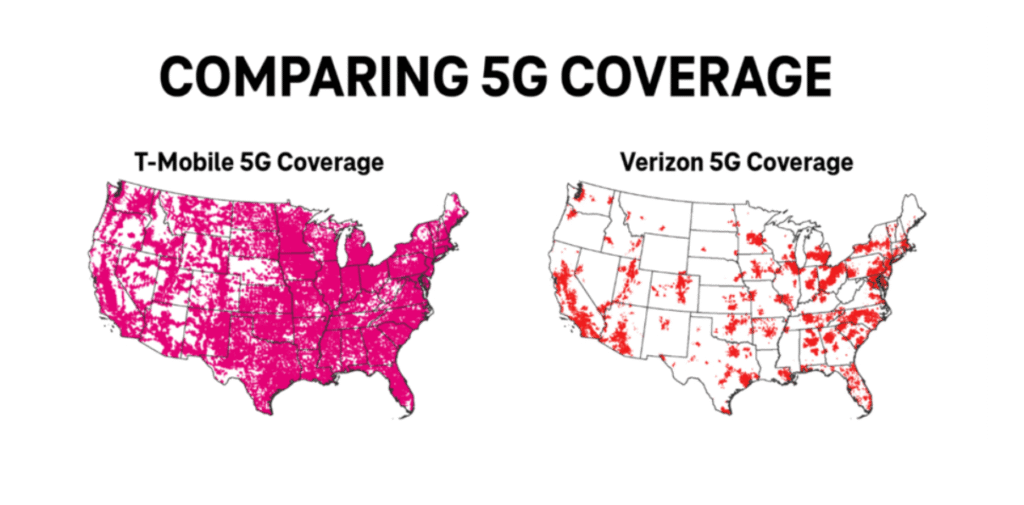Introduction
With the rise of remote work, streaming, online gaming, and smart homes, having fast and reliable internet is more important than ever. T-Mobile 5G Home Internet has emerged as a competitive alternative to traditional broadband providers, promising simplicity, no contracts, and wide 5G coverage across the U.S.
T-Mobile’s coverage map offers an exciting glimpse into its network reach, showing where users can expect high-speed 5G connectivity. However, many people wonder how accurate these maps really are—and what the real-world experience looks like once you plug in the 5G gateway. That’s where the difference between “map” and “reality” becomes essential to understand.
In this article, we take a deep dive into what the T-Mobile 5G Internet map shows, how accurate it is, what factors affect actual performance, and whether it lives up to its promise. We’ll also explore user experiences, troubleshooting tips, and expert advice for those considering the switch. If you’re thinking about trying T-Mobile 5G Internet, this guide will help you make an informed decision based on facts—not just marketing claims.
What the T-Mobile 5G Coverage Map Shows
The T-Mobile 5G coverage map is designed to give potential customers a snapshot of where its high-speed internet is available. This interactive tool, found on T-Mobile’s official website, allows you to enter your ZIP code or full address to check the estimated coverage in your area—making it especially useful for home and business users considering the switch.
The map displays two key types of 5G coverage:
- 5G Ultra Capacity (Mid-band/High-band): This is the faster, more reliable 5G experience. It’s marked in dark magenta and offers speeds that can rival traditional cable or fiber internet. It works best in urban and suburban areas with upgraded tower infrastructure.
- 5G Extended Range (Low-band): Shown in lighter pink, this version of 5G covers more ground and penetrates buildings better but delivers slower speeds than Ultra Capacity. It’s often what users see in rural or edge areas.
While the map offers a great starting point, it represents predicted coverage, not guaranteed performance. T-Mobile updates it frequently based on tower deployment and testing data. However, it may not reflect temporary outages, network congestion, or physical obstacles like trees and walls.
Before switching, it’s wise to treat the coverage map as a guide, not a promise. The next sections will explore how it compares to real-world performance—and what you should do to verify coverage at your location.
How Accurate is the Map?
The T-Mobile 5G coverage map is a useful tool—but like all predictive maps, it has limitations. While it’s designed to give you a general sense of where 5G signals should reach, the real-world experience can vary widely depending on several factors.
First, it’s important to understand that the map reflects theoretical coverage based on tower proximity, signal strength models, and terrain analysis. It doesn’t always account for obstacles such as thick building walls, tree density, or interference from other wireless devices. So while your address might fall in a “covered” zone, actual signal strength inside your home or office could be much weaker.
User reports from across the U.S. often show mixed experiences. In some urban neighborhoods, speeds match or exceed what the map suggests—especially with 5G Ultra Capacity. But in many suburban or rural areas, users have noted weaker signals and slower speeds than expected. This can be due to tower distance, line-of-sight issues, or high network usage at peak times.
Another limitation is that the map typically doesn’t distinguish between indoor and outdoor performance. Even if your area is shown as fully covered, indoor speeds may be noticeably slower due to building material interference.
To get a true sense of how accurate the map is for your location, consider doing a 15-day free trial (offered by T-Mobile), running speed tests at different times of day, and checking community forums or reviews from neighbors.
In short, the map provides a helpful overview, but actual performance depends on where you are, how you use the internet, and what environment you’re in. Always test before committing.
Real-World User Experiences
While the T-Mobile 5G coverage map looks promising on paper, real-world user experiences reveal a more nuanced picture. Across the U.S., customers have shared mixed feedback—ranging from lightning-fast connections to frustratingly weak signals—all depending on location and environment.
In urban areas, many users report excellent results. For example, a small business owner in Brooklyn, NY switched to T-Mobile 5G Home Internet and immediately noticed smoother video calls, faster uploads, and steady download speeds around 300 Mbps. These results closely matched what the coverage map predicted for Ultra Capacity 5G.
However, suburban and rural customers often encounter a different reality. A family in northern Kentucky, despite living in a “fully covered” zone, experienced signal drops during peak hours and inconsistent download speeds below 50 Mbps. Thick walls and long distances from the nearest 5G tower seemed to be key factors.
Some mobile users have found success by placing the 5G gateway near a window or using external antenna boosters. Others mention that performance improves overnight when the network is less congested, indicating that usage volume impacts experience.
T-Mobile does offer a 15-day test period, and many users recommend using that time to run speed tests, stream content, and work as usual to gauge whether the service fits your needs.
In forums like Reddit and community reviews, users often suggest managing expectations—especially if switching from fiber or cable. While some find T-Mobile 5G a fantastic cost-saving alternative, others view it as a backup rather than a full replacement.
In short, real-world experience depends heavily on your exact location, home setup, and how you use the internet—making testing essential before switching.
Factors That Impact Real-Life Coverage
While T-Mobile’s 5G coverage map offers a general view of availability, your actual internet performance can vary due to several real-world factors. Understanding these can help you get the most from your connection—or avoid unexpected slowdowns.
1. Building Materials
Homes or offices made with thick concrete, brick, or metal often block 5G signals. Basements, in particular, tend to have weak reception. Even newer homes with energy-efficient insulation can unintentionally interfere with signal strength.
2. Router or Gateway Placement
Where you place the T-Mobile 5G gateway device matters. For the best signal, it should be near a window and as high off the ground as possible. Avoid putting it in enclosed spaces or behind electronics that can block signal transmission.
3. Distance to the Nearest Tower
If you’re far from a T-Mobile 5G tower—especially one supporting Ultra Capacity 5G—you may receive a weaker signal or connect to the slower Extended Range 5G instead. Signal strength drops significantly with distance and obstructions.
4. Network Congestion
During peak hours (e.g., evenings), many users connect simultaneously, which can lead to slower speeds. This is particularly noticeable in densely populated neighborhoods or apartment complexes.
5. Weather and Terrain
Heavy rain, snow, and even dense trees can interfere with signal quality. Similarly, valleys or hills can cause patchy coverage due to line-of-sight limitations.
6. Device Compatibility
Older phones, laptops, or routers may not fully support T-Mobile’s 5G bands. Make sure your devices are compatible with both n41 (Ultra Capacity) and n71 (Extended Range) for the best performance.
Understanding these factors helps set realistic expectations and allows you to optimize your setup for better speed and stability.
How to Test Before Switching
Before committing to T-Mobile 5G Internet, it’s smart to test the service at your location to ensure it meets your expectations. While coverage maps offer an estimate, only real-world testing can confirm actual speeds and reliability in your home or business.
Try the Free Trial
T-Mobile offers a 15-day risk-free trial for both home and business 5G internet users. This allows you to test the service at your exact address with no obligation. If you’re unsatisfied, you can cancel within the trial period without paying a cent.
Use Speed Testing Tools
Once your 5G gateway is set up, use tools like Speedtest.net or Fast.com to check download and upload speeds, latency, and network consistency throughout the day. Run tests during both peak and off-peak hours to understand how the connection performs under different conditions.
Test in Multiple Rooms
Move your device or laptop to various rooms while connected to Wi-Fi. This helps identify weak spots in your home or office and evaluate how walls or floors affect signal strength. Consider trying the gateway in different locations, ideally near windows or elevated spots.
Simulate Real Use
During the trial, go about your typical internet usage—stream videos, join video calls, upload files, and browse. This will help you see how the service handles your daily workload.
Ask Neighbors or Read Local Reviews
If others in your neighborhood are using T-Mobile 5G Internet, ask about their experience. Online communities like Reddit and local Facebook groups can also provide helpful insights from nearby users.
Testing before switching gives you confidence in the service and helps avoid surprises after activation.
Pros and Cons of T-Mobile 5G Internet
T-Mobile 5G Internet has become a popular alternative to traditional broadband, especially for those looking for flexibility and lower costs. However, like any service, it comes with both benefits and trade-offs. Here’s a detailed look:
✅ Pros
- Easy Setup: There’s no need for technicians, drilling, or cables. The 5G gateway is plug-and-play—just place it near a window, power it up, and you’re online within minutes.
- No Contracts or Hidden Fees: T-Mobile offers simple pricing with no annual commitments or surprise charges. You can cancel anytime.
- Wide Coverage: With the expansion of T-Mobile’s 5G network, many suburban and urban areas now have solid coverage, especially for 5G Ultra Capacity users.
- Competitive Pricing: For $50–$60/month, you get unlimited data, making it a strong value for households or small businesses that stream, work remotely, or game.
- Free Trial: The 15-day trial gives you a no-risk opportunity to test the service before switching.
❌ Cons
- Inconsistent Performance: Depending on your location and time of day, speeds can vary. Areas far from towers or with high congestion may experience slowdowns.
- Limited Support in Rural Areas: While 5G Extended Range offers broad coverage, rural users may not get the high speeds seen in metro areas.
- Device Limitations: Some older devices may not support the newer 5G bands, which can impact your experience.
- Gateway Placement is Critical: Signal strength can drop drastically if the gateway is placed in the wrong spot, such as a basement or behind thick walls.
Expert Tips Before Making the Switch
Switching to T-Mobile 5G Internet can be a smart move, but getting the best experience requires a little preparation. Here are some expert tips to make sure your switch is smooth and successful.
1. Check Your Coverage Carefully
Start by entering your address on the T-Mobile coverage map. Look for areas marked as 5G Ultra Capacity (dark magenta) for the fastest and most reliable service. If you’re in a light pink zone (Extended Range), expect moderate speeds.
2. Test Before You Commit
Take advantage of the 15-day free trial. During this period, test your usual online activities—streaming, Zoom calls, online gaming, uploads, and downloads—to see if performance meets your needs.
3. Optimize Gateway Placement
Your 5G gateway should be placed near a window with a clear line to the outside. Avoid corners, basements, or rooms with thick walls. The better the signal, the faster the speed.
4. Use Speed Testing Tools
Apps like Speedtest.net or Fast.com can help you measure performance in different parts of your home. If you notice weak spots, consider moving the gateway or using mesh Wi-Fi for wider coverage.
5. Know Your Current ISP Terms
Before switching, check for cancellation fees or equipment returns with your current provider. You don’t want surprise charges.
6. Ask the Community
Forums like Reddit, YouTube reviews, or local Facebook groups can provide real-world feedback from users in your area.
By following these tips, you can confidently decide if T-Mobile 5G Internet is the right choice—and make the most of it from day one.
Alternatives to Consider if Coverage is Weak
If T-Mobile 5G Internet doesn’t deliver the performance you need due to weak signal or inconsistent speeds, don’t worry—there are several alternative options worth exploring based on your location and usage needs.
1. Cable Internet (e.g., Xfinity, Spectrum)
Cable internet remains one of the most reliable choices, offering fast and stable connections for both homes and businesses. If fiber isn’t available in your area, cable is often the next best option.
2. Fiber-Optic Internet (e.g., Verizon Fios, AT&T Fiber)
If you’re lucky enough to have fiber coverage, it offers unmatched speed, low latency, and rock-solid reliability—ideal for streaming, gaming, and remote work.
3. Other 5G Providers (e.g., Verizon, AT&T)
Both Verizon and AT&T offer 5G home internet services. Coverage varies by area, so checking their maps and running a free trial can help you compare real-world results with T-Mobile.

4. Fixed Wireless Providers
Companies like Starry or Rise Broadband offer fixed wireless internet by transmitting signals from towers to receivers at your home. This option is growing in urban and suburban areas.
5. Satellite Internet (e.g., Starlink)
For rural users, Starlink is a top choice. It offers global coverage with decent speeds via low-orbit satellites. While pricier and with some weather sensitivity, it’s a strong option where traditional broadband fails.
6. Mobile Hotspots
If your data needs are light, a mobile hotspot using your existing phone plan may offer enough speed for email, browsing, and video calls.
Before committing, always test available options using free trials or local reviews. A little research now saves a lot of frustration later.
Conclusion
T-Mobile 5G Internet is an exciting option for those seeking flexibility, affordability, and modern connectivity. With no contracts, easy setup, and expanding 5G coverage, it’s a strong contender—especially in urban and suburban areas. However, real-world performance can vary based on factors like tower distance, network congestion, and building materials.
Before making the switch, use T-Mobile’s 15-day free trial to test the service thoroughly at your location. Check speeds, placement, and reliability during peak hours. If coverage is weak, explore alternatives like fiber, cable, or even satellite solutions like Starlink.
Informed decisions lead to better online experiences. So, take the time to test, compare, and choose the internet that truly fits your lifestyle or business needs. Whether you stick with T-Mobile or opt for another provider, being proactive ensures smoother connectivity in the long run.



